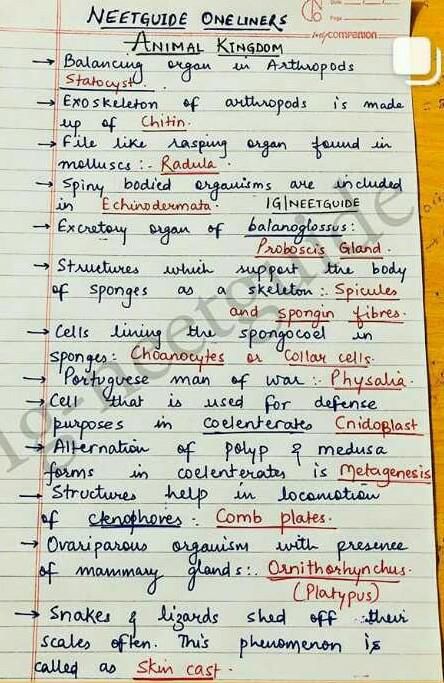NEET Exam > NEET Questions > Few important points from the chapter "Animal...
Start Learning for Free
Few important points from the chapter "Animal kingdom" part-1?
Most Upvoted Answer
Few important points from the chapter "Animal kingdom" part-1?

Community Answer
Few important points from the chapter "Animal kingdom" part-1?
Key Points from the chapter "Animal Kingdom" part-1:
- Kingdom Animalia is divided into various phyla based on their characteristics and evolutionary relationships.
- The phylum Porifera includes sponges, which are multicellular organisms with porous bodies.
- Cnidarians are a phylum that includes organisms like jellyfish and corals, which have radial symmetry and stinging cells called cnidocytes.
- Phylum Platyhelminthes consists of flatworms, which are flattened, unsegmented animals with bilateral symmetry.
- Nematodes, or roundworms, belong to the phylum Nematoda and have a cylindrical body with a complete digestive system.
- Annelids are segmented worms belonging to the phylum Annelida, which includes earthworms and leeches.
- Arthropods, the largest phylum in the animal kingdom, include insects, crustaceans, and arachnids, with jointed appendages and an exoskeleton.
- Mollusks, such as snails, clams, and octopuses, are soft-bodied animals belonging to the phylum Mollusca.
- Echinoderms, like starfish and sea urchins, are marine animals with a spiny skin and a water vascular system, found in the phylum Echinodermata.
- Chordates, the most advanced phylum, include vertebrates like fish, amphibians, reptiles, birds, and mammals, with a notochord and dorsal nerve cord at some stage of their life cycle.
Understanding the diversity and characteristics of these phyla is essential for studying the animal kingdom and its evolution. Each phylum represents a unique evolutionary path and adaptation to its environment, providing valuable insights into the complexity of life on Earth.
- Kingdom Animalia is divided into various phyla based on their characteristics and evolutionary relationships.
- The phylum Porifera includes sponges, which are multicellular organisms with porous bodies.
- Cnidarians are a phylum that includes organisms like jellyfish and corals, which have radial symmetry and stinging cells called cnidocytes.
- Phylum Platyhelminthes consists of flatworms, which are flattened, unsegmented animals with bilateral symmetry.
- Nematodes, or roundworms, belong to the phylum Nematoda and have a cylindrical body with a complete digestive system.
- Annelids are segmented worms belonging to the phylum Annelida, which includes earthworms and leeches.
- Arthropods, the largest phylum in the animal kingdom, include insects, crustaceans, and arachnids, with jointed appendages and an exoskeleton.
- Mollusks, such as snails, clams, and octopuses, are soft-bodied animals belonging to the phylum Mollusca.
- Echinoderms, like starfish and sea urchins, are marine animals with a spiny skin and a water vascular system, found in the phylum Echinodermata.
- Chordates, the most advanced phylum, include vertebrates like fish, amphibians, reptiles, birds, and mammals, with a notochord and dorsal nerve cord at some stage of their life cycle.
Understanding the diversity and characteristics of these phyla is essential for studying the animal kingdom and its evolution. Each phylum represents a unique evolutionary path and adaptation to its environment, providing valuable insights into the complexity of life on Earth.
Attention NEET Students!
To make sure you are not studying endlessly, EduRev has designed NEET study material, with Structured Courses, Videos, & Test Series. Plus get personalized analysis, doubt solving and improvement plans to achieve a great score in NEET.

|
Explore Courses for NEET exam
|

|
Similar NEET Doubts
Few important points from the chapter "Animal kingdom" part-1?
Question Description
Few important points from the chapter "Animal kingdom" part-1? for NEET 2024 is part of NEET preparation. The Question and answers have been prepared according to the NEET exam syllabus. Information about Few important points from the chapter "Animal kingdom" part-1? covers all topics & solutions for NEET 2024 Exam. Find important definitions, questions, meanings, examples, exercises and tests below for Few important points from the chapter "Animal kingdom" part-1?.
Few important points from the chapter "Animal kingdom" part-1? for NEET 2024 is part of NEET preparation. The Question and answers have been prepared according to the NEET exam syllabus. Information about Few important points from the chapter "Animal kingdom" part-1? covers all topics & solutions for NEET 2024 Exam. Find important definitions, questions, meanings, examples, exercises and tests below for Few important points from the chapter "Animal kingdom" part-1?.
Solutions for Few important points from the chapter "Animal kingdom" part-1? in English & in Hindi are available as part of our courses for NEET.
Download more important topics, notes, lectures and mock test series for NEET Exam by signing up for free.
Here you can find the meaning of Few important points from the chapter "Animal kingdom" part-1? defined & explained in the simplest way possible. Besides giving the explanation of
Few important points from the chapter "Animal kingdom" part-1?, a detailed solution for Few important points from the chapter "Animal kingdom" part-1? has been provided alongside types of Few important points from the chapter "Animal kingdom" part-1? theory, EduRev gives you an
ample number of questions to practice Few important points from the chapter "Animal kingdom" part-1? tests, examples and also practice NEET tests.

|
Explore Courses for NEET exam
|

|
Suggested Free Tests
Signup for Free!
Signup to see your scores go up within 7 days! Learn & Practice with 1000+ FREE Notes, Videos & Tests.

























